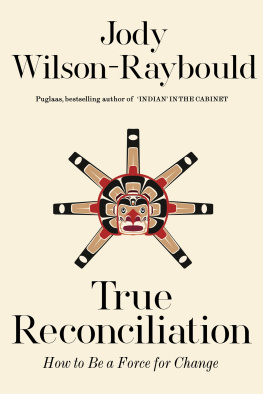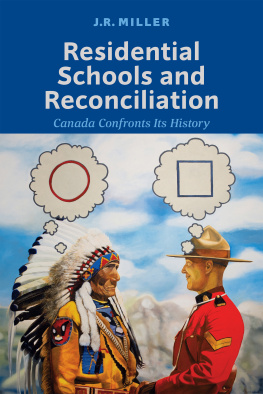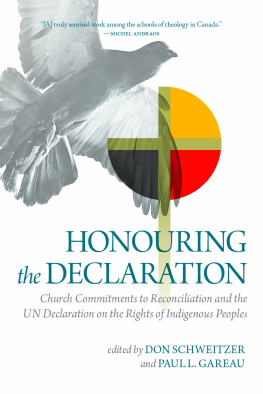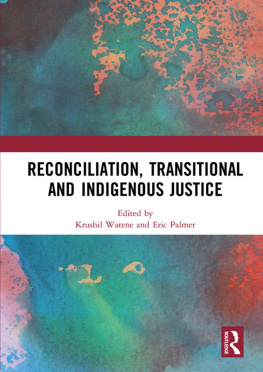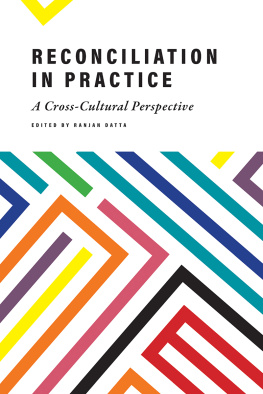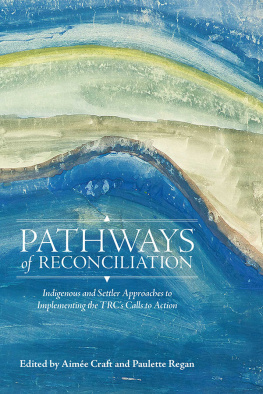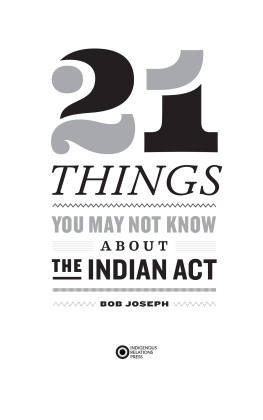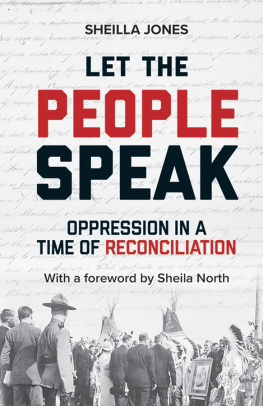DANIELLE METCALFE-CHENAIL is Edmontons Historian Laureate, author of Polar Winds and For the Love of Flying , and an occasional columnist for CBC Radio Active. She is a founding member of Reconciliation in Solidarity Edmonton and is currently researching and writing about the complex history and legacy of the Charles Camsell Indian Hospital in that city. daniellemc.com @danicanuck
IN THIS
TOGETHER
FIFTEEN STORIES OF
TRUTH & RECONCILIATION
Edited by
DANIELLE METCALFE-CHENAIL
Selection and arrangement 2016 by Danielle Metcalfe-Chenail
Copyright to the individual essays are retained by the contributors.
Brindle & Glass Publishing
An imprint of TouchWood Editions
1031075 Pendergast Street
Victoria, BC V8V 4E4
Brindleandglass.com
All rights reserved. No part of this publication may be reproduced, stored in a retrieval system, or transmitted in any form or by any means, electronic, mechanical, photocopying, recording, or otherwise, without the prior written permission of the publisher.
Cover and interior design by Pete Kohut
Issued in print and electronic formats.
ISBN 978-1-927366-45-5 (epub)
We acknowledge the financial support of the Government of Canada through the Canada Book Fund and the Canada Council for the Arts, and of the province of British Columbia through the British Columbia Arts Council and the Book Publishing Tax Credit.
For all our relations
INTRODUCTION
DANIELLE METCALFE-CHENAIL
THERE WERE TWENTY-FIVE of us chatting on folding grey chairs in the program room at an Edmonton, Alberta, public library. We fell silent when Miranda Jimmy, a young Cree organizer and community leader, called the meeting to order. Miranda, wearing glasses and an intricate turquoise clip at the top of her long, dark braid, invited us to stand. We joined hands in a circle as she recited a secular prayer: that we find inner strength and comfort in the group; that we take care of ourselves; that we ask for what we needa moment, a tissue, a hug. As we went around that circle introducing ourselves, I realized we were made up of a range of ages, backgrounds, ethnicities, and genders. There were City representatives, parents, artists, writers, educators, students, and community workers.
Miranda told us how she recently recognized she needed to start sharing her experiences of intergenerational trauma brought about by the residential school system with the wider Canadian society. For the past decade, she had shared with other survivors, but she worried that the energy generated by the Truth and Reconciliation Commission ( TRC ) and Edmontons Year of Reconciliation would fizzle. She was worried the TRC would be all political rhetoric and no real change.
Most of her Aboriginal friends were cautiously waiting to see what came of the first meeting, she said, and as we introduced ourselves, only three people self-identified as Indigenous. Her friends were frustrated with repeated failed attempts at communicating their concerns and sick of being consulted, she added. I saw nods from the group. A mtis woman in the circle who worked for the City echoed their sentiments: Im feeling cynical right now, she said, her shoulders slumped forward.
There were a lot of other feelings identified that evening as we went around the circle. One non-Indigenous person said they felt ashamed of the past. Another, a relatively recent immigrant to Canada, said the enormity of the issue of reconciliation was overwhelming. Many mentioned wanting to do things right through proper protocol and a sensitive approach; not knowing where to turn to figure this out, they found themselves paralyzed.
One of the other participants, a mtis poet called Anna Marie Sewell, prompted, Just begin.
This collection of essays is only one of many ways to begin the work of reconciliation in our country. We recognize that we dont hold all the answers in these pages, but in the contributors aha or light bulb moments around our countrys colonial past and present, we hope to seriously (and at times humorously) question the status quo. The authors included in this anthology are journalists, writers, scholars, visual artists, filmmakers, a former city planner, and a lawyer. They are Indigenous and non-Indigenous individuals from Tofino to Igloolik to Halifax. In these pieces they investigate their ancestors roles in creating the country we live in today, and how we might move forward together in respectful partnership. They look at their own assumptions and experiences under a microscope in hopes that you will do the same.
This project was born out of a phone conversation between Brindle & Glass associate publisher Taryn Boyd and me in late March 2014. We had never spoken before then, but we quickly realized we had a lot in common as lapsed academics interested in Canadas colonial history. At the time, the TRC events were concluding in Edmonton and our conversation kept circling around how to keep discussions going in mainstream Canada. Finally, in an aha moment of her own, Taryn suggested we work on this collection. I was excited. And terrified of doing it wrong.
Just begin.
As a white, middle-class woman and as a student, writer, and now Edmontons Historian Laureate, Ive wrestled with a lot of the same questions as the contributors. And, as is the case for many of the essays youll read here, it hasnt just been one big aha moment for me, but a series of light bulbs going off:
- Its 1991 and Im nine years old watching TV in our Ottawa home. There are soldiers and police in full riot gear facing off against men in camouflage. There are guns. I hear that its in a place called Oka (Kanehsetake) near Montral, Qubec, where a lot of my fathers family lives. I remember thinking, Why are these people so mad at each other? How can this be happening in Canada?
- In middle school I do projects on les Iroquois but its all longhouses and cornno golf courses or Sacred Pines in sight. My mother does contract work for the federal government and I make pocket money as a teen helping her sort news clippings that come by the box-load. I scan and highlight the articles, sorting them into piles, while I listen to my Discman. In this way I learn about Davis Inlet and the Innu in Labrador, kids in their teens like me who are living in abject poverty, huffing gas, dying in house fires, and killing themselves in suicide pacts. I try to understand the situation and share it with my Grade 13 classmates in our Families in Canadian Society class.
- There are rumours in the family that one of our ancestors is Indigenous but passed for whiteRgina Lagesse or la sauvagesse, as some called her. I cant understand why someone would be ashamed of being Aboriginal and hide it from the world.
Like many non-Indigenous people who wake up to this reality in our country, at first I looked at it in very simplistic terms: black and white, victim and victor, oppressor and oppressed. As a natural defender of the underdog, I came face to face quite suddenly with feelings of white guilt and wanted to do something to fix the situation. Luckily, I had fantastic teachers along the way at McGill University and the University of British Columbia who saved me from my own good intentions and taught me about the complexities of colonialism. I learned about agency and how power works, and about race and gender and class and how they intersect. Some of it was through really theoretical texts Im still not sure I understand, but some was through powerful personal narratives. These stories embodied the theoriesliterally theory made fleshand made it all real to me.


